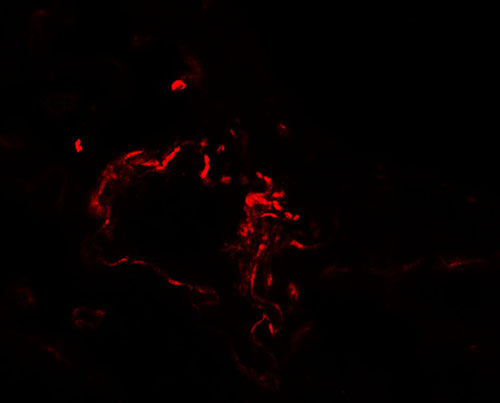ACSL1 Antibody
- 产品详情
- 实验流程
- 背景知识
Application
| WB, IF, E |
|---|---|
| Primary Accession | P33121 |
| Other Accession | NP_001986, 40807491 |
| Reactivity | Human, Mouse, Rat |
| Host | Rabbit |
| Clonality | Polyclonal |
| Isotype | IgG |
| Calculated MW | 77943 Da |
| Concentration (mg/ml) | 1 mg/mL |
| Conjugate | Unconjugated |
| Application Notes | ACSL1 antibody can be used for detection of ACSL1 by Western blot at 1 - 2 µg/mL. For immunofluorescence start at 20 µg/mL. |
| Gene ID | 2180 |
|---|---|
| Other Names | Long-chain-fatty-acid--CoA ligase 1, 6.2.1.3, Acyl-CoA synthetase 1, ACS1, Long-chain acyl-CoA synthetase 1, LACS 1, Long-chain acyl-CoA synthetase 2, LACS 2, Long-chain fatty acid-CoA ligase 2, Palmitoyl-CoA ligase 1, Palmitoyl-CoA ligase 2, ACSL1, FACL1, FACL2, LACS, LACS1, LACS2 |
| Target/Specificity | ACSL1; At least three isoforms of ACSL1 are known to exist; this antibody will detect all three isoforms. |
| Reconstitution & Storage | ACSL1 antibody can be stored at 4℃ for three months and -20℃, stable for up to one year. As with all antibodies care should be taken to avoid repeated freeze thaw cycles. Antibodies should not be exposed to prolonged high temperatures. |
| Precautions | ACSL1 Antibody is for research use only and not for use in diagnostic or therapeutic procedures. |
| Name | ACSL1 (HGNC:3569) |
|---|---|
| Function | Catalyzes the conversion of long-chain fatty acids to their active form acyl-CoAs for both synthesis of cellular lipids, and degradation via beta-oxidation (PubMed:21242590, PubMed:22633490, PubMed:24269233). Preferentially uses palmitoleate, oleate and linoleate (PubMed:24269233). Preferentially activates arachidonate than epoxyeicosatrienoic acids (EETs) or hydroxyeicosatrienoic acids (HETEs) (By similarity). |
| Cellular Location | Mitochondrion outer membrane; Single-pass type III membrane protein. Peroxisome membrane; Single-pass type III membrane protein. Microsome membrane; Single-pass type III membrane protein. Endoplasmic reticulum membrane; Single-pass type III membrane protein |
| Tissue Location | Highly expressed in liver, heart, skeletal muscle, kidney and erythroid cells, and to a lesser extent in brain, lung, placenta and pancreas. |
For Research Use Only. Not For Use In Diagnostic Procedures.
Provided below are standard protocols that you may find useful for product applications.
BACKGROUND
ACSL1 Antibody: Long-chain acyl coenzyme A synthetase 1 (ACSL1) catalyzes the synthesis of acyl-CoA from long-chain fatty acids in an ATP-dependent manner. ACSL1 is a member of a family of long-chain acyl-CoA synthetases which differ in substrate preference, tissue expression, and subcellular localization. In mouse, ASCL1 is the major acyl-CoA enzyme in the heart, providing 60-90% of heart ATP. Loss of ASCL1 either globally or in heart ventricles resulted in impaired fatty acid oxidation, activation of the mammalian target of rapamycin (mTOR), and cardiac hypertrophy.
REFERENCES
Black PN and DiRusso CC. Transmembrane movement of exogenous long-chain fatty acids: proteins, enzymes, and vectorial esterification. Microbiol. Mol. Biol. Rev. 2003; 67:454-72.
Coleman RA, Lewin TM, Van Horn CG, et al. Do acyl-CoA synthetases regulate fatty acid entry into synthetic versus degradative pathways? J. Nutr. 2002; 132:2123-6.
Clark H, Carling D, and Saggerson D. Covalent activation of heart AMP-activated protein kinase in response to physiological concentrations of long-chain fatty acids. Eur. J. Biochem. 2004; 271:2215-24
Ellis JM, Mentock SM, DePetrillo MA, et al. Mouse cardiac acyl Coenzyme A synthetase 1 deficiency impairs fatty acid oxidation and induces cardiac hypertrophy. Mol. Cell. Biol. 2011; 31:1252-62.
终于等到您。ABCEPTA(百远生物)抗体产品。
点击下方“我要评价 ”按钮提交您的反馈信息,您的反馈和评价是我们最宝贵的财富之一,
我们将在1-3个工作日内处理您的反馈信息。
如有疑问,联系:0512-88856768 tech-china@abcepta.com.























 癌症的基本特征包括细胞增殖、血管生成、迁移、凋亡逃避机制和细胞永生等。找到癌症发生过程中这些通路的关键标记物和对应的抗体用于检测至关重要。
癌症的基本特征包括细胞增殖、血管生成、迁移、凋亡逃避机制和细胞永生等。找到癌症发生过程中这些通路的关键标记物和对应的抗体用于检测至关重要。 为您推荐一个泛素化位点预测神器——泛素化分析工具,可以为您的蛋白的泛素化位点作出预测和评分。
为您推荐一个泛素化位点预测神器——泛素化分析工具,可以为您的蛋白的泛素化位点作出预测和评分。 细胞自噬受体图形绘图工具为你的蛋白的细胞受体结合位点作出预测和评分,识别结合到自噬通路中的蛋白是非常重要的,便于让我们理解自噬在正常生理、病理过程中的作用,如发育、细胞分化、神经退化性疾病、压力条件下、感染和癌症。
细胞自噬受体图形绘图工具为你的蛋白的细胞受体结合位点作出预测和评分,识别结合到自噬通路中的蛋白是非常重要的,便于让我们理解自噬在正常生理、病理过程中的作用,如发育、细胞分化、神经退化性疾病、压力条件下、感染和癌症。







